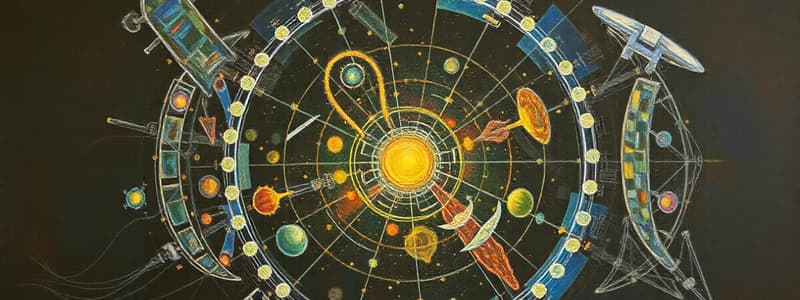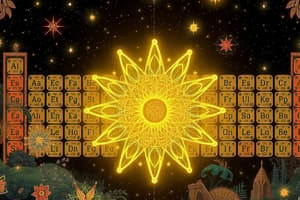Podcast
Questions and Answers
Which of the following quantities directly corresponds to the number of protons in an atom?
Which of the following quantities directly corresponds to the number of protons in an atom?
- Atomic weight
- Mass number
- Atomic number (correct)
- Number of neutrons
Isotopes are atoms of the same element that have the same number of protons but different numbers of neutrons.
Isotopes are atoms of the same element that have the same number of protons but different numbers of neutrons.
True (A)
What is the primary process involved in nuclear transmutation?
What is the primary process involved in nuclear transmutation?
Nuclear transmutation involves bombarding nuclei with particles like neutrons, protons, or other nuclei.
The process of radioactive decay involves unstable nuclei emitting ______ and electromagnetic radiation.
The process of radioactive decay involves unstable nuclei emitting ______ and electromagnetic radiation.
Match the following concepts with their corresponding definitions:
Match the following concepts with their corresponding definitions:
Which of the following will always remain constant in a balanced nuclear reaction?
Which of the following will always remain constant in a balanced nuclear reaction?
How do we determine the number of neutrons in an atom?
How do we determine the number of neutrons in an atom?
The process of nuclear transmutation can be used to create new elements that do not naturally occur on Earth.
The process of nuclear transmutation can be used to create new elements that do not naturally occur on Earth.
Flashcards
Atomic Number
Atomic Number
The number of protons in an atom, which determines its identity.
Mass Number
Mass Number
The total number of protons and neutrons in an atomic nucleus.
Isotopes
Isotopes
Atoms that have the same atomic number but different mass numbers due to varying neutrons.
Nuclear Transmutation
Nuclear Transmutation
Signup and view all the flashcards
Radioactivity
Radioactivity
Signup and view all the flashcards
Balancing Nuclear Reactions
Balancing Nuclear Reactions
Signup and view all the flashcards
Protons
Protons
Signup and view all the flashcards
Neutrons
Neutrons
Signup and view all the flashcards
Study Notes
Review of Last Meeting
- No meeting details provided.
Structure of the Atom
- Atoms consist of a nucleus containing protons and neutrons, with electrons orbiting the nucleus.
- Protons carry a positive charge, neutrons are neutral, and electrons are negative.
Objectives
- Students will be able to explain how atomic number relates to the synthesis of new elements in a lab. (S11/12PS-IIIb-11)
Phone Numbers
- The importance of phone numbers lies in their function as communication tools.
- No further details on phone numbers.
The Periodic Table of Elements
- The periodic table organizes elements based on their atomic number.
- Elements are arranged in rows (periods) and columns (groups) based on their electronic structure and chemical properties.
- The table provides details on atomic mass, symbol, name, electron configuration, oxidation states, 1st ionization energy, as well as electronegativity.
Significant Numbers in the Periodic Table
- Atomic number: identifies the number of protons in an element.
- Atomic mass: the total number of protons and neutrons of an element.
- Electronegativity: measures the ability of an atom to attract shared electrons in a chemical bond.
- Oxidation states: the possible charges an element can have in a compound.
- First ionization energy: Energy required to remove the outermost electron from a neutral atom.
- Chemical Symbol, name, electron configuration are also provided.
The Structure of the Atom (Carbon Example)
- Carbon has 6 protons and 6 neutrons, totaling 12.0107 atomic mass units.
- Electrons orbit the atom.
Atomic Number, Mass, and Particles Summary
- Atomic number equals the number of protons and electrons.
- Atomic mass equals the total number of protons and neutrons.
Denoting Atomic Number and Mass Number
- The format for representing an element's identity includes the mass number (A) and atomic number (Z).
- Atomic number (Z) is shown as a subscript and atomic mass (A) represented as a superscript.
Mass Number vs Atomic Number
- The example image shows the difference between mass number (top) and atomic number (bottom), used to represent an element.
Subatomic Particle Numbers & Elements
- To find the number of protons, neutrons, or electrons, use the atomic number (Z) and mass number (A). Protons = atomic number, Number of neutrons = mass number minus atomic number, number of electrons = atomic number.
Isotopes
- Isotopes of an element have the same atomic number but different mass numbers due to varying neutron numbers. (e.g. Protium, Deuterium, Tritium are all Hydrogen isotopes. )
Nuclear Reactions in New Element Synthesis
- Radioactivity: Unstable nuclei undergo radioactive decay, emitting various particles and energy. (Examples: Alpha decay)
- Nuclear transmutation: Bombarding nuclei with particles (neutrons, protons, or other nuclei) creates new elements. (Examples: using accelerators)
Cosmic Nucleosynthesis
- Big Bang Nucleosynthesis: Created light elements like hydrogen, helium, lithium, and beryllium.
- Stellar Nucleosynthesis: Created intermediate elements (from carbon to iron) in stars.
- Supernova Nucleosynthesis: Created heavy elements beyond iron in supernova explosions.
Balancing Nuclear Reactions
- The total atomic numbers must remain the same on both sides of an equation, and the total mass numbers must remain the same.
Identifying Subatomic Particle Numbers
- To find the number of protons, neutrons, and electrons, use the atomic number and mass number.
Practice Exercises (Partial)
- A table for completing Atomic data for different elements is provided, including aluminum (Al), potassium, nitrogen and others.
Completing Nuclear Reactions & Cosmic Phases (Partial)
- Examples of nuclear reactions to complete and identify the associated cosmic phase are provided.
Studying That Suits You
Use AI to generate personalized quizzes and flashcards to suit your learning preferences.




